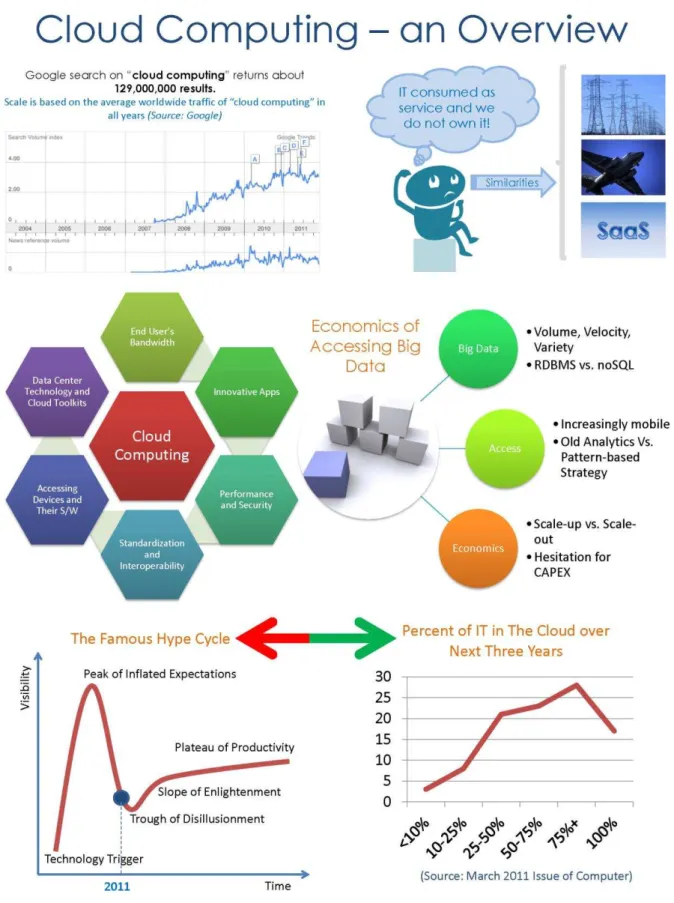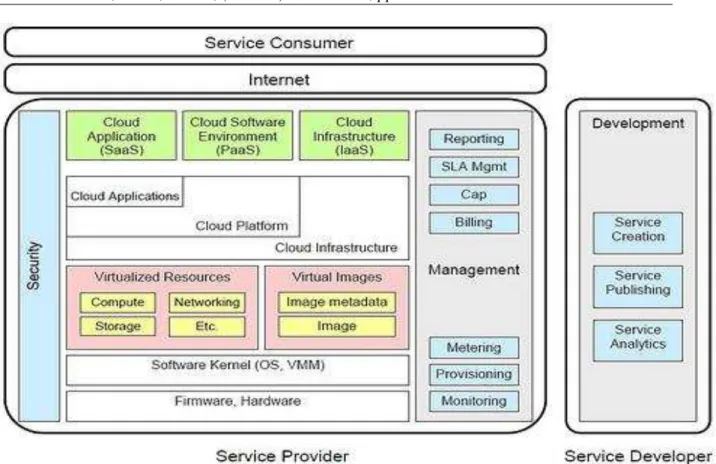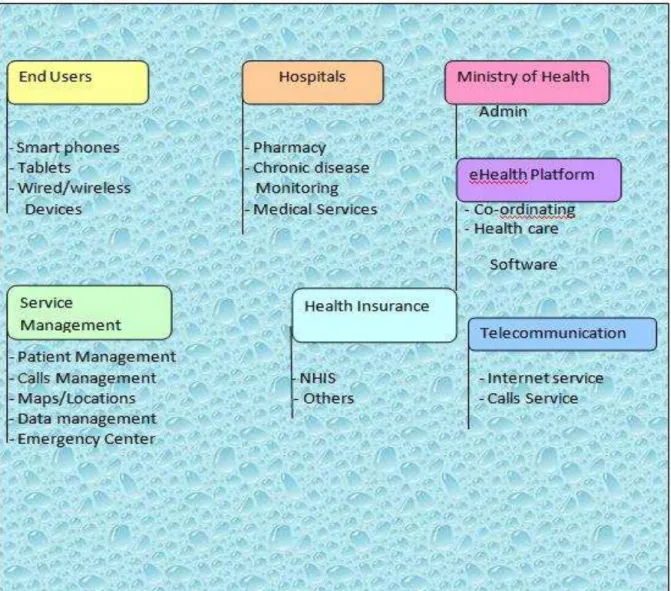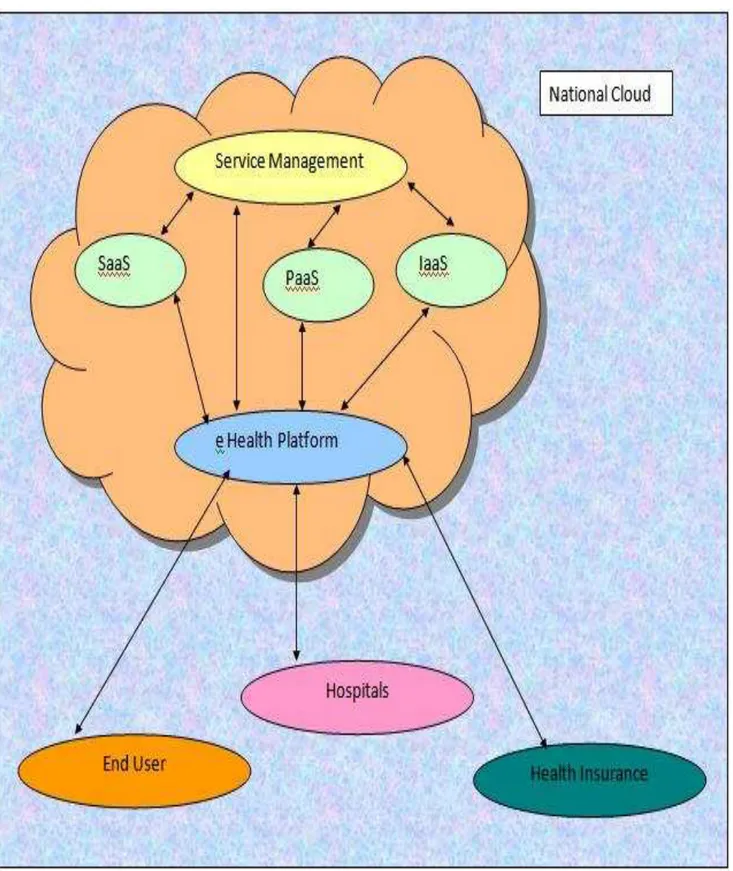The Adoption of a National Cloud Framework for Healthcare
Delivery in Nigeria
Chinedu Ukeje*, Oni .O.A**
*(Department of Computer Studies, The Polytechnic Ibadan, Ibadan Oyo State Nigeria) ** (Department of Computer Studies, The Polytechnic Ibadan, Ibadan Oyo State Nigeria)
ABSTRACT
National cloud framework (NCF) , based on the cloud computing framework, is the idea of a cloud that is completely owned and managed by the government of a country for the sole purpose of delivering social amenities for the citizenry of that country with the aim of achieving the mandate of governance.The emergence of the internet and more specifically the idea of a cloud have brought about the application of information technology in almost all area of human activities, one such area is the healthcare sector.This paper tries to draw out a framework for the adoption of eHealth into cloud computing through the NCF model for the easy delivery of healthcare services by the government of Nigeria.The paper tries to address challenges concerning eHealth as regards Nigeria health sector and how the NCF model will help resolve these issues and also propose the adoption of this framework by other developing countries.
Keywords
–Cloud Computing, e-Health, National Cloud, Information Technology, frameworkI.
INTRODUCTION
Since the introduction of the internet, the movement of information and the flow of knowledge have greatly increased. This is without a doubt a very good development;the internet has proven to be
man’s greatest discovery since the invention of the computer. This discovery has given rise to a new era called the information age where access to useful information is power. Hence the prediction that organizations like Google will be the leading force in
the future due to their interest in providing “data centric” services to people. This is made possible through the technology called cloud computing. When you store information like photos online instead of your local computer or you use a webmail service provided by Google or Yahoo or when you post your information on social networking site like
Facebook you are using a “Cloud Computing”
service.
If you are an organization or an institute, and you want to use, for example, an online word processing service instead of updating the in-house one you have been using for many years, that online word processing service is a “cloud computing” service.The following definition of cloud computing has been developed by the U.S. National Institute of Standards and Technology (NIST):
“Cloud computing is a model for enabling convenient, on-demand network access to a shared pool of configurable computing resources (e.g., networks, servers, storage, applications, and services) that can be rapidly provisioned and released with minimal management effort or service provider interaction. This cloud model promotes
availability and is composed of five essential characteristics, three service models, and four deployment models.”
1.1 CHARACTERISTICS OF CLOUD
COMPUTING
The characteristics of cloud computing include on-demand self-service, broad network access, resource pooling, rapid elasticity and measured service.
A. On-demand self-service means that customers (usually organizations or institutes) can request and manage their own computing resources. B. Broad network access allows services to be
offered over the Internet or private networks or a hybrid of the two.
C. Pooled resources means that customers draw from a pool of computing resources, usually in remote data centers.
D. Services can be scaled larger or smaller; and use of a service is measured and customers are billed accordingly.
Though the concept of “clouds” is not new, it is
undisputable that they have proven a major commercial success over recent years and will play a large part in the ICT domain over the next 10 years or more, as future systems will exploit the capabilities of managed services and resource provisioning further. Clouds are of particular commercial interest not only with the growing tendency to outsource IT so as to reduce management overhead and to extend existing, limited IT infrastructures, but even more importantly, they reduce the entrance barrier for new
service providers to offer their respective capabilities to a wide market with a minimum of entry costs and infrastructure requirements – in fact, the special capabilities of cloud infrastructures allow providers to experiment with novel service types whilst reducing the risk of wasting resources.
1.2 eHealth: a brief history
The term "e-health", coined in the latter part of the twentieth century, can already be found in around6,000,000 Web pages. In the latter part of the nineteenth and early part of the twentieth century,medical applications were quick to derive benefit from the progress being made in the field ofanalogue telephony(using analogue technology). The technology enabled not only individuals to call the doctor but also hospitalsto transmit electrocardiograms over telephone lines. These were the early days of "tele"-medicine, ormedical care delivered remotely. However, bandwidth limitations and the consequent low rate of datatransfer over the copper wires then in use, coupled with interference and various types of noise, put abrake on the expansion of these analogue techniques.Since then, the boom in data digitization, computerization and digital networks witnessed since themid-twentieth century has moved beyond telemedicine and has led to a multiplicity of e-healthapplications. These have emerged from academic research laboratories and have increasingly becomepart of people's everyday lives.Digital telemedicine has experienced tremendous growth over the past 27 years and is now a majorcomponent of e-health. It enables, among other things, the exchange of healthcare and administrativedata and the transfer of medical images and laboratory results. Improvement in these processes hasgone hand-in-hand with the technological progress that is generating ever higher bandwidths, greaterstorage and processing capacities, smaller and smaller components and higher levels of security. Thishas occurred in the context of decreasing costs and increasingly user-friendly features. It is nowreasonable to expect that by 2019 every inhabitant of our planet will, from any location and at anytime, be able to access the medical information necessary to maintain his or her health or seek a curefor his or her illness.To take up WHO's famous "Health for all in 2000" declaration, made in Alma Ata, we may now speakof "e-health for all in 2015" as being a credible and realistic objective – and one which it is our sharedresponsibility to achieve.Different definitions have been used over time to designate ICT applications in the service of health.Around 1970, the term "medical informatics", considered at the time to be state-of-the-art technology,was used to refer to the processing of medical data by computers. However, the importance of"information processing" was to be rapidly
superseded by that of "information communication", asseen in the extremely rapid development of the Internet.Health applications then became known as "health telematics" or "telemedicine", and now "e health".The acceleration of transfer rates over networks of interconnected computers (currently in the order ofseveral gigabytes per second) has removed all barriers to the exchange of medical data, physiologicalsignals and medical imagery between computers. The standardization of exchange protocols betweencomputers, such as the Internet Protocol for example, in addition to the improved structuring ofmedical data and data security rules, is increasingly making it possible for health professionals indifferent locations to understand one another and work together, despite differences in languages. It isnow clear that the value of these applications lies not in the technology itself, or even in the exchangeof data, but in the ability to develop human networks of competence and expertise in the field ofhealth and this is the area in which the National Cloud Framework will play a major role.In short, this new way of working – networking all those involved in the health enterprise – is rapidlyexpanding thanks to technological progress.The common denominator in all of these technologies is data digitization, without which data couldnot have been processed and exchanged in the manner to which we have become accustomed. This iswhy, rather than proposing a series of more or less restrictive academic definitions for the use of ICT 12/53 Implementing eHealth in Developing Countriesin healthcare, the consensus approach is to bring all of these applications together under the term "ehealth”.
The term "health" is used broadly and does not refer solely to medicine, disease, healthcare orhospitals. The scope of e-health is health in general, with its two major facets, namely public health –which is the responsibility of States and is geared towards preventing and responding to disease inpopulations – and healthcare, which is geared towards individual patients and the treatment of disease.Although healthcare accounts for over 95 per cent of health expenditure in the majority of countries, itshould not be forgotten that public health (including diseases relating to the environment, ageing,predictive medicine, and so on) is, and will continue to be, at the heart of sustainable health systems inboth rich and developing countries alike.The notion of e-health thus covers all aspects of health, not only healthcare. The term is graduallyevolving to refer to the skeletal structure for
all health systems’ functions. It is not simply a matter
countries health systems andthereby move towards the overall improvement of health on a global scale.
II.
HEALTHCARE SERVICES
Healthcare services refer to services rendered by healthcare institutions and healthcare professionals, these services ranges from diagnosis to prescriptions and all other services related to the healthcare sector.The National Cloud Framework seeks toreflect the growing impact that eHealth is bringing to the delivery of health care services in the Nigerian health sector, and how it is making health systems more
efficient and more responsive to people’s needs and
expectations. Technological advances, economic investment, and social and cultural changes are also contributing to the realization that the health sector must now integrate technology into its way of doing business in Nigeria and more especially other third world countries. The daily business of health in all its aspects – from individual care to humanitarian action
– relies on information and communication and, increasingly, on the technologies that enable it, at every level and in every state of the country. Experience shows that harnessing ICT for health requires strategic and integrated action at the national level, to make the best use of existing capacity while providing a solid foundation for investment and innovation. Establishing the main directions as well as planning the detailed steps needed is essential to achieving longer-term goals such as health sector efficiency, reform or more fundamental transformation. Collaboration between the health sector and ICT sector, both public and private, is central to the attainment of this goal.
The Nigerian ministry of health will play an important role, not only in meeting the needs of the citizenry for care and protection of public health, but also in preserving the Nigerian health care system through uncertain times. The ministryof information technology and telecommunications are crucial to development in all spheres, and can make a vital contribution to the health sector. Common goals and a predictable ICT environment enable coordinated action: building consensus on policy, facilitating better use of shared resources and involvement of the private sector, and investment in skills and infrastructure to improve health outcomes in the country.
III.
THE CHALLENGES OF
E-HEALTH IN NIGERIA
Given the fact that Nigeria is a developing country, the delivery of health care services through
the internet is a major challenge. The fact that there is no national database poses a great challenge to the development of information and communication technology (ICT) facilities to support the development of a nationwide application that can house the information ofcitizens of the country. The absence of a national database can in a large extent hinder the implementation of an ehealth system because the ehealth system is based on the idea of storing patient information for the purpose of using the information for future reference. Another factor militating against the design and implementation of an ehealth solution is the inability of telecommunication providers and key decision makers in government to reach an agreement as regards a steady delivery of internet services to the citizenry of the country and most of the internet service providers deliver internet access at exorbitant costs. This development has created or is contributing to the increasing digital divide between developing countries and developed countries. Thirdly, research and academic institutions are not doing enough to contribute to the development of research ideas in this area and also recommending frameworks that will help improve the development of an active ehealth platform for the country.This is mainly due to the fact that the lack of a platform that will present information on research works conducted by other researchers so as to facilitate collaboration is not readily available thereby limiting information exchange and contribution to knowledge. And finally, local health professionals and health institutions are unable to work together by sharing resources and patient health information. The limiting factors discussed above are some of the major challenges of ehealth development in Nigeria.
IV.
THE PROPOSED NATIONAL
CLOUD FRAMEWORK
Figure 2 cloud computingarchitecture
The national cloud framework that we are proposing seeks to build a service platform for personal health management, which provides a communication bridge for the end users and the medical institutions in the country.The framework seeks to provide professional medical health services by integrating all existing medical institutions (whether private or public) and medical resources in the country.
Users can access the platform through a wireless or wired device and acquire medical services in real time. The framework offers an information platform for trans-regional and real time medical health services, such as chronic disease control, medical emergency response, maternal and child health care, and regional medical services. The framework will optimize medical resource utilization and reduces the cost and inconvenience of visiting a medical institution. Hence the whole medical system or model is transformed from one of treatment to one of prevention.
The National Cloud Framework hopes to achieve the following objectives:
A. Sharing of medical information
The national cloud and eHealth framework will provide a platform for storing and sharing of an
individual’s health data. This will help medical
institutions and other certified health workers immediately retrieve health records and allocate
medical resources more effectively. This will, to a large extent, increase efficiency in medical response time and thereby save lives.
B. Efficiency of service
Advance technologies in medical information technology (medical IT) provides digital and intelligent hospital operations that boost service and management efficiency. This can be through the
uploading of a patients scan result and MRI’s to the
eHealth platform of the National cloud so that any other medical institution can actually have access to it for medical purposes. That way even if a patient goes to another medical institution, the scan and MRI can still be accessed by that institution without having to do another scan or MRI.
C. Preventive Measures
The preventive measure aspect of the system arises from the intelligent monitoring of an
individual’s health and analysis of records. By so
doing, the solution may give health care advice by assessing future risks. This changes health management from treatment to prevention.
D. Extension of Medical Services
government mandate as regards good health care delivery to the masses; for instance, the remote monitoring of diseases and out-patient management and information service provisions
E. Understanding of Citizen Medical Status The framework facilitates the storing of patient information, hence making possible for the medical workers to access a patient’s medical history and health status. This ensures that no contradictions exist during diagnosis and treatment.
Figure 4 National Cloud and eHealth Framework.
F. Scalability
The framework will offer scalability by allowing users access to health care services at very reasonable rates and with any mobile device that has internet facility. This will also allow the users in the rural
areas access to doctors and medical diagnosis and treatment over the internet.
V.
CONCLUSION
researchers in the discipline. The paper also narrows this study down to the peculiar case of Nigeria, and how the adoption of the National Cloud Framework (NCF) can integrate the advantages of cloud computing and the electronic health platform into a framework that can be managed by the government of the country for the purpose of delivering good health care services to its citizenry. The main purposeof this paper is to spell out the framework for the National Cloud Framework and the objectives of the framework.
REFERENCES
[1] L. Wang, Gregor Laszewski, Marcel Kunze,
Jie Tao,“Cloud Computing: A Perspective Study”, New Generation Computing- Advances of Distributed Information Processing, pp. 137-146, vol. 28, no. 2, 2008. DOI: 10.1007/s00354-008-0081-5 [2] R. Maggiani, Communication Consultant,
Solari Communication, “Cloud Computing is Changing How we Communicate”, 2009 IEEE International Professional Conference, IPCC, pp. 1-4, Waikiki, HI, USA, July 19- 22, 2009. ISBN: 978-1-4244-4357-4. [3] Harold C. Lin, Shivnath Babu, Jeffrey S.
Chase, Sujay S. Parekh, “Automated Control in Cloud Computing: Opportunities and Challenges”, Proc. of the 1stWorkshop on Automated control for data centres and clouds, New York, NY, USA, pp. 13-18, 2009, ISBN: 978-1-60558-585-7.
[4] Peter Mell, Timothy Grance, “The NIST Definition of Cloud Computing”, Jan, 2011. http://docs.ismgcorp.com/files/external/Draf t-SP-800-145_cloud-definition.pdf
[5] Meiko Jensen, Jorg Schwenk, Nils Gruschka, Luigi Lo Iacon, “On technical Security Issues in Cloud Computing”, Proc. of IEEE International Conference on Cloud Computing (CLOUD-II, 2009), pp. 109-116, India, 2009.
[6] B.P. Rimal, Choi Eunmi, I. Lumb, “A Taxonomy and Survey of Cloud Computing Systems”, Intl. Joint Conference on INC, IMS and IDC, 2009, pp. 44-51, Seoul, Aug, 2009. DOI: 10.1109/NCM.2009.218
[7] Gaoyun Chen, Jun Lu and Jian Huang, Zexu
Wu, “SaaAS - The Mobile Agent based Service for Cloud Computing in Internet Environment”, Sixth International Conference on Natural Computation,ICNC 2010, pp. 2935-2939, IEEE, Yantai, Shandong,China, 2010. ISBN: 978-1-4244-5958-2.
[8] Sangeeta Sen, Rituparna Chaki, “Handling Write Lock Assignment in Cloud Computing Environment”, Communications in
Computer and Information Science, vol. 245, issue. 7, pp. 221-230, 2011. DOI: 10.1007/978-3-642-27245-5_27
[9] S. Bhardwaj, L. Jain, and S. Jain, “Cloud computing: A study of infrastructure as a service (IAAS)”, International Journal of engineering and information Technology, 2(1):60–63, 2010.
[10] R. L. Grossman, “The Case for Cloud Computing”, IT Professional, vol. 11(2), pp. 23-27, Mar-April, 2009, ISSN: 1520-9202, INSPEC Accession Number: 10518970, DOI: 10.1109/MITP.2009.40.
[11] Shuai Zhang, Shufen Zhang, Xuebin Chen, Xiuzhen Huo, “Cloud Computing Research and Development Trend”, Intl. Conference on Future Networks, pp. 93- 97, China, 2010. DOI: 10.1109/ICFN.2010.58
[12] David Chappel, “A Short Introduction to Cloud Platforms: An Enterprise Oriented View”, David Chappel and Associates, August, 2008. [Sponsored by Microsoft Corporation]http://www.davidchappell.com/ CloudPlatforms--Chappell.pdf
[13] Qi Zhang, Lu Cheng, Raouf Boutaba,
“Cloud Computing: State of the art and research challenges”, Journal of Internet Services and Applications, pp. 7- 18, vol. 1, issue. 1, Feb, 2010.DOI: 10.1007/s13174-010-0007-6
[14] World Health Organization (WHO),
“National eHealth Strategy Toolkit Overview”,
[15] International Telecommunication Union
(ITU), “Implementing eHealth in Developing Countries: Guidance and Principles”, ICT Applications and Cybersecurity Division Policies and Strategies Department ITU Telecommunication Development Sector September 2008 DRAFT



